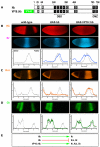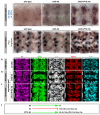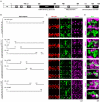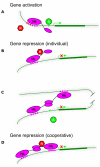Recombineering Hunchback identifies two conserved domains required to maintain neuroblast competence and specify early-born neuronal identity
- PMID: 20335359
- PMCID: PMC2853844
- DOI: 10.1242/dev.048678
Recombineering Hunchback identifies two conserved domains required to maintain neuroblast competence and specify early-born neuronal identity
Abstract
The Hunchback/Ikaros family of zinc-finger transcription factors is essential for specifying the anterior/posterior body axis in insects, the fate of early-born pioneer neurons in Drosophila, and for retinal and immune development in mammals. Hunchback/Ikaros proteins can directly activate or repress target gene transcription during early insect development, but their mode of action during neural development is unknown. Here, we use recombineering to generate a series of Hunchback domain deletion variants and assay their function during neurogenesis in the absence of endogenous Hunchback. Previous studies have shown that Hunchback can specify early-born neuronal identity and maintain 'young' neural progenitor (neuroblast) competence. We identify two conserved domains required for Hunchback-mediated transcriptional repression, and show that transcriptional repression is necessary and sufficient to induce early-born neuronal identity and maintain neuroblast competence. We identify pdm2 as a direct target gene that must be repressed to maintain competence, but show that additional genes must also be repressed. We propose that Hunchback maintains early neuroblast competence by silencing a suite of late-expressed genes.
Figures






Similar articles
-
Identification of hunchback cis-regulatory DNA conferring temporal expression in neuroblasts and neurons.Gene Expr Patterns. 2012 Jan-Feb;12(1-2):11-7. doi: 10.1016/j.gep.2011.10.001. Epub 2011 Oct 20. Gene Expr Patterns. 2012. PMID: 22033538 Free PMC article.
-
Pdm and Castor close successive temporal identity windows in the NB3-1 lineage.Development. 2008 Nov;135(21):3491-9. doi: 10.1242/dev.024349. Epub 2008 Oct 2. Development. 2008. PMID: 18832394 Free PMC article.
-
Enhancer of trithorax/polycomb, Corto, regulates timing of hunchback gene relocation and competence in Drosophila neuroblasts.Neural Dev. 2022 Feb 17;17(1):3. doi: 10.1186/s13064-022-00159-3. Neural Dev. 2022. PMID: 35177098 Free PMC article.
-
Brn3/POU-IV-type POU homeobox genes-Paradigmatic regulators of neuronal identity across phylogeny.Wiley Interdiscip Rev Dev Biol. 2020 Jul;9(4):e374. doi: 10.1002/wdev.374. Epub 2020 Feb 3. Wiley Interdiscip Rev Dev Biol. 2020. PMID: 32012462 Review.
-
From temporal patterning to neuronal connectivity in Drosophila type I neuroblast lineages.Semin Cell Dev Biol. 2023 Jun;142:4-12. doi: 10.1016/j.semcdb.2022.05.022. Epub 2022 May 31. Semin Cell Dev Biol. 2023. PMID: 35659165 Free PMC article. Review.
Cited by
-
Neuroblast-specific open chromatin allows the temporal transcription factor, Hunchback, to bind neuroblast-specific loci.Elife. 2019 Jan 29;8:e44036. doi: 10.7554/eLife.44036. Elife. 2019. PMID: 30694180 Free PMC article.
-
The Hunchback temporal transcription factor determines motor neuron axon and dendrite targeting in Drosophila.Development. 2019 Apr 5;146(7):dev175570. doi: 10.1242/dev.175570. Development. 2019. PMID: 30890568 Free PMC article.
-
The making of a lymphocyte: the choice among disparate cell fates and the IKAROS enigma.Genes Dev. 2017 Mar 1;31(5):439-450. doi: 10.1101/gad.297002.117. Genes Dev. 2017. PMID: 28385788 Free PMC article. Review.
-
Single-cell transcriptomics of X-ray irradiated Drosophila wing discs reveals heterogeneity related to cell-cycle status and cell location.bioRxiv [Preprint]. 2025 Feb 11:2024.12.10.627868. doi: 10.1101/2024.12.10.627868. bioRxiv. 2025. PMID: 39990483 Free PMC article. Preprint.
-
The Hunchback transcription factor determines interneuron molecular identity, morphology, and presynapse targeting in the Drosophila NB5-2 lineage.PLoS Biol. 2025 Mar 31;23(3):e3002881. doi: 10.1371/journal.pbio.3002881. eCollection 2025 Mar. PLoS Biol. 2025. PMID: 40163536 Free PMC article.
References
-
- Albertson R., Chabu C., Sheehan A., Doe C. Q. (2004). Scribble protein domain mapping reveals a multistep localization mechanism and domains necessary for establishing cortical polarity. J. Cell Sci. 117, 6061-6070 - PubMed
-
- Baumgardt M., Karlsson D., Terriente J., Diaz-Benjumea F. J., Thor S. (2009). Neuronal subtype specification within a lineage by opposing temporal feed-forward loops. Cell 139, 969-982 - PubMed
-
- Berman B. P., Nibu Y., Pfeiffer B. D., Tomancak P., Celniker S. E., Levine M., Rubin G. M., Eisen M. B. (2002). Exploiting transcription factor binding site clustering to identify cis-regulatory modules involved in pattern formation in the Drosophila genome. Proc. Natl. Acad. Sci. USA 99, 757-762 - PMC - PubMed
-
- Berman B. P., Pfeiffer B. D., Laverty T. R., Salzberg S. L., Rubin G. M., Eisen M. B., Celniker S. E. (2004). Computational identification of developmental enhancers: conservation and function of transcription factor binding-site clusters in Drosophila melanogaster and Drosophila pseudoobscura. Genome Biol. 5, R61 - PMC - PubMed
Publication types
MeSH terms
Substances
Grants and funding
LinkOut - more resources
Full Text Sources
Molecular Biology Databases

